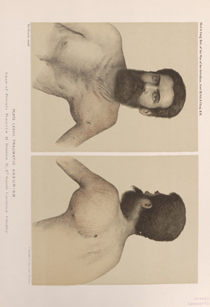Title: Denton, F. M.
Source text: The Medical and Surgical History of the War of the Rebellion. (1861-65.), Part 3, Volume 2 (Washington, DC: Government Printing Office, 1883), 809.
Civil War Washington ID: med.d2e28110
TEI/XML: med.d2e28110.xml
CASE 1181.—Private F. M. Denton, Co. H, 4th South Carolina Cavalry, aged 34 years, was wounded at Hanovertown, May 28, 1864. Surgeon L. W. Read, U. S. V., reported the patient's admission into the field hospital of the 3d division, Fifth Corps, with "gunshot wounds of abdomen and arm; sent to general hospital." On June 5th he was admitted into Lincoln Hospital, Washington. Assistant Surgeon J. C. McKee, U. S. A., reported: "Minié ball entered three inches below left shoulder joint anteriorly, passed through the axilla under the scapula, and emerged one inch to the right of the vertebral margin. July 1st, suffers much pain in the hand and region of the wound. July 4th, arm easy; hand very painful. The daily use of hypodermic injections of morphia, etc., relieved the pain a little. August 28th, swelling in region of wound, extending over pectoral and axillary regions, to vertebral border of scapula, left side, continuing to increase from day to day. Upon consultation it was determined to be an aneurismal tumor, and pressure by spiral bandage advised, which was continued until September 1st, when the tumor increased very rapidly. The patient was quite irritable and weak. Chloroform was administered and ligation of the subclavian artery was performed. On opening the sac the tissues were found so diffused with blood and disorganized that amputation at the shoulder joint was advised and performed. Two ligatures were placed on the external jugular vein and three at the shoulder. About eighty ounces of blood, mostly coagulated, were removed from the aneurism. After the operation the patient rallied considerably. He died September 2, 1864, at 10 o'clock A. M., from exhaustion." The operator, Dr. McKee, contributed to the Army Medical Museum photographs of the anterior and posterior appearances of the aneurismal swelling, which have been accurately copied in PLATE LXXVII.
